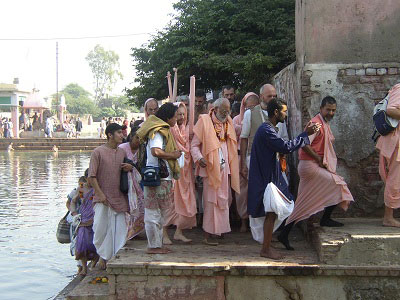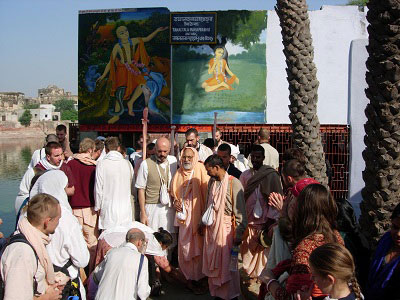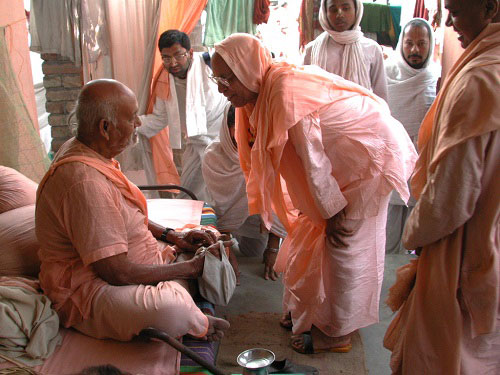Tridandisvami Sri Srimad Bhaktivedanta Narayana Gosvami Maharaja
[Respected Readers,
In honor of the divine appearance day of Sri Radha-kunda, please recieve the following explanation of Sri Radha-kunda from Srila Narayana Gosvami Maharaja's Vraja Mandala Parikrama Book:]
Sri Radha-kunda is within Bahulavana, and for this reason there is a custom to take bath in Sri Radha-kunda on the day of Bahulastami. A huge assembly of people take bath in Sri Radha-kunda on that day.
The Padma Purana states:
yatha radha priya visnoh tasyah kundam priyam tatha
sarvagopisu sevaika visnoratyantavallabha
"Among all the gopis, Srimati Radhaji is most dear to Sri Krsna, being His principal prana vallabha. Similarly, Radhaji's dear kunda is also very dear to Him."
The Varaha Purana declares:
sarvapapaharastirtham namaste harimuktidah
namah kaivalyanathaya radhaKrsnabhidhayine
"O Sri Radha-kunda! O Sri Krsna Kunda! You destroy all sins and award one-pointed prema. I bow down to you again and again." The puranas are filled with innumerable descriptions of the glories of these two kundas.
In Vraja-vilasa-stava (text 53), Srila Raghunatha dasa Gosvami prays:
sri-vrindavipinam suramyam api tac chriman sa govardhanah
sa rasa-sthalikapy alam rasamayi kim tavad anyat sthalam
yasyapy amsa-lavena narhati manak samyam va mukundasya tat
pranebhyo 'py adhika-priyeva dayitam tat kundam evasraye
"Not even Sri Vrindavana, which is supremely delightful because of places like the rasa filled rasa-sthali, or Sriman Govardhana, which is the arena of the nectarian rasa where the most confidential amorous pastimes (keli-krida) of the Divine Couple take place, are equal to even a shadow of a particle of the glories of Sri Radha-kunda, what to speak of other pastime-places within Braja Mandala. I take shelter of this Sri Radha-kunda, which is more dear to Sri Mukunda than His own life."
 Sri Radha-kunda lies in a village named Arita Gaon, about three miles north-east of Govardhana and fourteen miles from Mathura and Vrindavana. Aristasura was a servant of Kamsa who assumed the form of a bull and attacked Krsna with the aim of killing Him. However, Krsna killed him instead at this place.
Sri Radha-kunda lies in a village named Arita Gaon, about three miles north-east of Govardhana and fourteen miles from Mathura and Vrindavana. Aristasura was a servant of Kamsa who assumed the form of a bull and attacked Krsna with the aim of killing Him. However, Krsna killed him instead at this place.
At Sri Radha-kunda, Sri Radha-Krsna Yugala perform Their midday (madhyahnik) lila-vilasa. Here They perform a variety of amorous pastimes freely and without any obstruction. This is not possible anywhere else. Therefore, Radha-kunda is considered to be the topmost place of bhajana, superior even to Nandagaon, Barsana, Vrindavana and Govardhana. This most confidential place, surcharged with paramount bhavas, was revealed by Sri Caitanya Mahaprabhu Himself, who is endowed with the bhava (sentiment) and kanti (lustre) of Sri Radha. Previously, Sri Madhavendra Puri, Sri Lokanatha Gosvami and Sri Bhugarbha Gosvami also came to Braja, where they revealed various pastime-places of Krsna; but they did not reveal this confidential place, which was manifested by Sri Gaurasundara Himself, who is Sri Radha and Krsna combined.
Sri Krsna killed Aristasura during the day. That same night, He met with His beloved Sri Radhika and the other sakhis here. Sri Krsna was very eager to embrace Srimati Radhika, but as soon as He reached out towards Her, She stepped back. Jokingly, She said, "Today, You have killed a bull, which belongs to the cow family. You have therefore committed the sin of killing a cow. Please don't touch My pure body."
Krsna smilingly answered, "Priyatame! It was a demon that I killed, who had deceitfully assumed the form of a bull; so how can sin even touch Me?"
Srimatiji insisted, "Whatever he was, he had assumed the form of a bull when You killed him. Hence, the sin of killing a cow has definitely touched You." The sakhis supported Her statements.
Sri Krsna asked how He could atone for this sin. Smilingly, Srimatiji answered, "The only atonement is to take bath in all the tirthas of the entire Earth planet." Hearing this, Sri Krsna created an extensive kunda simply by striking His heel on the ground. He then summoned all the tirthas of the entire planet to it. Uncountable tirthas immediately came before Krsna in their personified forms. Krsna asked them to enter the kunda in the form of water. In a moment, the kunda filled with pure, sacred water. Sri Krsna took bath in that kunda and again tried to touch Srimatiji. But Srimati Radhika now wanted to manifest a kunda full of water that was larger and more exquisite than Krsna's, in response to Her Priyatama's bragging. She and Her sakhis therefore stubbornly dug out a very attractive kunda nearby with their bracelets. However, not so much as a drop of water appeared in it. Krsna joked that they could take water from His kunda, but Srimatiji along with Her innumerable sakhis prepared themselves to bring water from Manasi Ganga in clay pots. Sri Krsna signaled to the tirthas that they should insist that Srimatiji and Her sakhis fill up their kunda by taking water from His kunda. The tirthas personified pleased Srimati Radhika by offering Her and the sakhis many prayers. Srimati Radhika then gave them permission to enter Her kunda. Immediately, the current of water that had flowed into Krsna Kunda also filled Radha-kunda. With great pleasure, Sri Krsna bathed and performed water sports (jal-vihara) with Srimati Radhika and the sakhis in this dear kunda.
These two kundas manifested at midnight on Krsnastami (the eighth day of the dark moon) in the month of Kartika. Hundreds and thousands of people therefore bathe here at midnight on this day known as Bahulastami.
The Padma Purana states:
govardhana girau ramye radha-kundam priyam hareh
kartika bahulastamyam tatra snatva hareh priyah
naro bhakto bhaved vitatsthatasya tasya pratosanam
"Radiantly beautiful Sri Radha-kunda is situated at the foot of Govardhana Hill. Faithful persons who bathe here on Krsnastami in the Kartika month receive prema-bhakti filled with the seva of Sri Radha-Kunjabihari Sri Hari."
The Padma Purana also states:
dipotsave kartike ca radha-kunde yudhisthira
drisyate sakalam visvam bhrityair visnu-parayanaih
"On the day of Dipavali in the month of Kartika, the ekantika (one-pointed) bhaktas of Sri Radha-Krsna can see the entire universe and the complete Braja Mandala in Sri Radha-kunda."
 Outside Mahaprabhu's baithaka (sitting-place)Some time later, when Sri Krsna had left for Dvaraka, both kundas disappeared. While manifesting the pastime-places of Braja, Sri Krsna's great-grandson, Maharaja Vajranabha, again restored these two kundas under the guidance of Sandilya and other risis. Five thousand years later, however, they had again disappeared. When Sri Caitanya Mahaprabhu came to this place, He inquired from the local people about Radha-kundaand Syama Kunda, but they could provide Him with no information. Instead, they told Him about the two fields named Kali Khet and Gauri Khet that lay before them, which contained a little water. Mahaprabhu respectfully addressed Kali Khet as Syama Kunda and Gauri Khet as Radha-kunda and offered them His pranama. Then, as He bathed in them, He became overwhelmed. Losing all patience, He cried out, "Ha Radhe! Ha Krsna!," and fainted. The place where He sat down is now called Tamala Tala. It is also called Mahaprabhu's baithaka (sitting-place).
Outside Mahaprabhu's baithaka (sitting-place)Some time later, when Sri Krsna had left for Dvaraka, both kundas disappeared. While manifesting the pastime-places of Braja, Sri Krsna's great-grandson, Maharaja Vajranabha, again restored these two kundas under the guidance of Sandilya and other risis. Five thousand years later, however, they had again disappeared. When Sri Caitanya Mahaprabhu came to this place, He inquired from the local people about Radha-kundaand Syama Kunda, but they could provide Him with no information. Instead, they told Him about the two fields named Kali Khet and Gauri Khet that lay before them, which contained a little water. Mahaprabhu respectfully addressed Kali Khet as Syama Kunda and Gauri Khet as Radha-kunda and offered them His pranama. Then, as He bathed in them, He became overwhelmed. Losing all patience, He cried out, "Ha Radhe! Ha Krsna!," and fainted. The place where He sat down is now called Tamala Tala. It is also called Mahaprabhu's baithaka (sitting-place).
After the disappearance of Sri Caitanya Mahaprabhu, Sri Raghunatha dasa Gosvami came from Jagannatha Puri and performed bhajana at Radha-kunda. Once, the Mughal emperor Akbara was making his way along this path with his vast army. The entire army along with elephants, horses and camels were very thirsty. Akbara asked Dasa Gosvami, "Is there any big pond nearby?" Dasa Gosvami motioned to him to take water from Kali Khet and Gauri Khet. The emperor thought, "This water is not even sufficient for a single elephant. How will it quench the thirst of my entire army?" However, on the repeated requests of Dasa Gosvami, Emperor Akbara encouraged his men to drink. To his utter amazement, the entire army together with horses, elephants and camels drank to their full satisfaction, and yet the water in these ponds did not reduce even slightly. The emperor's astonishment knew no bounds.
After performing bhajana here for some time, the thought of restoring these two kundas entered Sri Raghunatha dasa Gosvami's mind. However, when he remembered the transcendental glories of Sri Radha-kunda, he began to reproach himself for thinking this. Just then, a wealthy person arrived at that place from Badrikasrama, looking for that supreme renunciate Sri Dasa Gosvami. He offered his dandavat pranamas (prostrated obeisances) at the feet of Gosvamiji and said, "I am returning from a pilgrimage to Badarikasrama. Bhagavan Sri Badri-Narayana has sent me to you. On His order I am offering to cover all the expenses required to restore these two kundas to their beautiful forms. Kindly accept my offer." Sri Dasa Gosvami became overjoyed. At first he rejected the offer, but he later relented, knowing it to be the desire of Sri Radha-Krsna. He thus began the work of re-constructing the two kundas.
Sri Radha-kunda easily manifested in the shape of an elegant quadrangle. The construction work on Syama Kunda then began, with the idea of giving it a quadrangular shape also. To achieve this, some trees on its bank needed to be cut down. That night, while Sri Dasa Gosvami was performing bhajana, he dozed off for a short time. In his dream, he saw five persons standing in front of him. "We are the five Pandavas," they said. "In the form of trees, we worship Yugala-Kisora here, so please don't cut us down. Rather, let the shape of the kunda be crooked." For this reason, Sri Dasa Gosvami did not have the trees cut down and instead allowed the kunda's shape to be crooked, just like Sri Krsna's shape. He only deepened the kunda and had its ghatas well repaired. Both kundas still have these shapes today, and only a few repairs have occasionally been carried out.
Sri Giriraja Govardhana stretches out from north to south and has the shape of a peacock. His tail in the south is called Puchari, and his two eyes on his face in the north are called Sri Radha-kundaand Sri Syama Kunda.
In Krsna-bhavanamrta, Srila Visvanatha Cakravarti Thakura describes Sri Radha-kundaand Sri Syama Kunda in a very delightful and charming way: Although Brajendranandana Sri Krsna is the source of all incarnations, is the origin of everything and is yet Himself without any origin, is akhila rasamritamurti (the personification of all nectarean mellows) and is sarva-saktiman (the source of all saktis), He is subservient to the prema of mahabhava svarupa Srimati Radhika, the topmost of all of Krsna's beloveds. He always establishes the glories of His priyatama Sri Kisoriji as superior to His own. Sri Radha-kunda and Syama-kunda are non-different from the svarupa of Sri Radha and Syamasundara, but Krsna Himself nonetheless gives more fame to Sri Radha-kunda.
In the northern part of Sri Radha-kundais the kunja of Sri Lalita-devi, Lalitanandada, which is shaped like a golden, eight-petalled lotus. In the north-east is Visakhanandada, the bejewelled kunja of Visakha Sakhi, which is shaped like a sixteen-petalled lotus. In the east is Citranandada, the kunja of Citra Sakhi, which displays an amazing variety of forms and colours. In the south-east is the kunja of Indulekha Sakhi, Indulekhanandada. It is shaped like an eight-petalled lotus and is made of diamonds. In the south is the kunja of Campakalata Sakhi, Campakalatanandada Kunja, which is shaped like a golden lotus. And in the south-west is the lotus-shaped kunja of Rangadevi, Rangadevi-sukhada, which is inlaid with blue sapphires. Tungavidyanandada is the kunja of Tungavidya Sakhi. This kunja is in the west and is shaped like a lotus made of red rubies. In the north-west lies Anandada or Sudevi-sukhada Kunja, the lotus-shaped kunja of Sudeviji, which is inlaid with emeralds. In the center of Sri Radha-kundais Anangamanjari-anandada Kunja shaped like a sixteen-petalled lotus inlaid with moonstones. This kunja is also known as Svanandasukhada Kunja, and is the kunja of Ananga Manjari. It is connected with the bank by a bridge made of moonstones.
Similarly, around Sri Syama-kunda are the kunjas of the sakhas. In the north-western area of the kunda is a delightful place made of diamonds, emeralds and other precious stones where Srimati Radhika daily takes bath. North of this place is Subalanandada Kunja, the kunja that Subala Sakha has offered to Srimati Radhika. Sri Radha-Krsna perform resting pastimes (sayana-vihara) here. In the northern part of Syama Kunda is the kunja of Madhumangalaji, Madhumangalanandada, which is inlaid with white jewels. He has offered this kunja to Lalitaji. Here Sri Yugala-Kisora enjoy all kinds of joking and laughing. Ujjvala Sakha's Ujjvalanandada Kunja in the north-east is made of red jewels, and he has given it to Visakha Sakhi. In the east is Arjuna Sakha's Arjunanandada Kunja, which is made of blue sapphires. He has offered this kunja to Citra Sakhi. Gandharvanandada Kunja in the south-east displays a variety of colours and forms, and belongs to Gandharva Sakha. He has offered it to Indulekha Sakhi. In the south is Vidagdhanandada Kunja belonging to Vidagdha Sakha, which is made of green emeralds. He has given this kunja to Campakalata. Here Yugala-Kisora play the game of chaupada1. Bhringa Sakha's Bhringanandada Kunja lies is in the south-west, and he has given this kunja to Rangadevi. In the west is Daksasanandananda Kunja made of a variety of jewels. Kokila Sakha's Kokilanandada Kunja is also in the west. He has given this kunja to Sudevi. At the sangama, or meeting place, of the two kundas is a platform made of many kinds of jewels. This place is also called the Yogapitha of Krsna-lila.
To the south of Sri Kunda are jeweled swings hanging from the branches of campaka trees. Swings inlaid with precious stones hang from the branches of kadamba trees to the east. To the west, swings made of jewels hang from the branches of mango trees, and to the north jewelled swings hang from the branches of bakula trees. Rasika Sri Krsna plays on these swings with Srimati Radhika and the other sakhis.
Surrounding both Radha-kunda and Syama-kunda are kalpataru trees of mango, jackfruit, kadamba, bakula and so forth, which are laden with an abundance of flowers and fruits. The bases of these trees are held by platforms of various precious stones. All seasons are eternally serving Sri Yugala under the guidance of the spring season. Vrnda-devi makes all the arrangements in a variety of ways for the seva of the Divine Couple. The cuckoos coo and the peacocks dance and make the sweet ke-ka sound. Blue and red lotuses and various kinds of ketaki flowers frolic on the waves of the sri kundas while intoxicated, buzzing bees hover above. Royal swans, cakravakas and cranes play in the water with their consorts, making sweet sounds. Different kinds of birds recite love poetry on the branches of the trees, thus giving pleasure to Sri Radha-Krsna Yugala. Deer and does roam about in the attractive kunjas nearby. Except for Srimati Radhika's most intimate girlfriends, no one can enter this forest.









